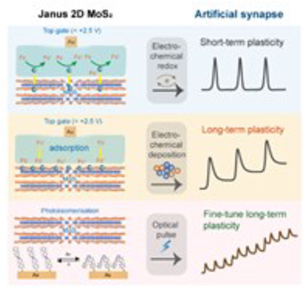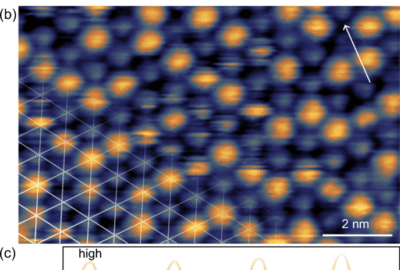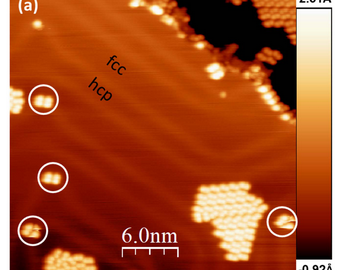publications, Réseau
Opto-electrochemical Synaptic Memory in Supramolecularly Engineered Janus 2d MoS2
Artificial synapses combining multiple yet independent signal processing strategies in a single device are key enabler to achieve high-density of integration, energy efficiency and fast data manipulation in brain-like computing. By taming functional complexity, the use of hybrids comprising multiple materials as active components in synaptic devices represents a powerful route to encode both short-term potentiation (STP) and long-term potentiation (LTP) in synaptic circuitries. To meet such a grand challenge, herein we have developed a novel Janus two-dimensional (2D) material by dressing asymmetrically the two surfaces of 2D molybdenum disulfide (MoS2) with an electrochemically-switchable ferrocene (Fc)/ ferrocenium (Fc+) redox couple and an optically-responsive photochromic azobenzene (Azo). Upon varying the magnitude of the electrochemical stimulus, it was possible to steer the transition between STP and LTP, thereby either triggering a Fc/Fc+ redox reaction or controlling an adsorption/desorption process of such redox species on MoS2. The adsorption/desorption process rules the programming of LTP states, whereas STP states are encoded through the chemical doping of MoS2 by tuning the electrochemical Fc/Fc+ equilibrium. In addition, a lower magnitude STP is recorded by activating the photoisomerization of azobenzene chemisorbed molecules and therefore modulating the dipole induced doping of the 2D semiconductor. Significantly, the interplay of electrochemical and optical stimuli makes it possible to construct artificial synapses where LTP can be boosted to 4-bit (16 memory states) while simultaneously also functioning as STP.
Ye Wang, Bin Han, Marcel Mayor, Paolo Samorì, Advanced Materials, 2023, link
Comments are closed






